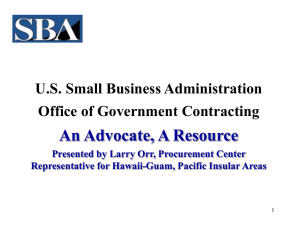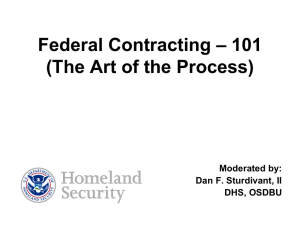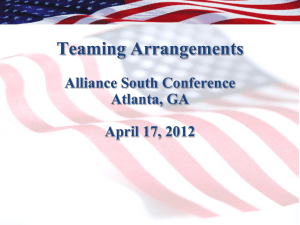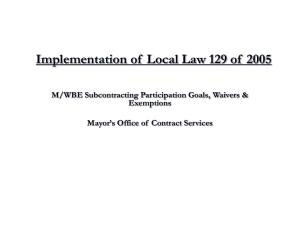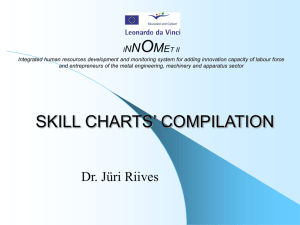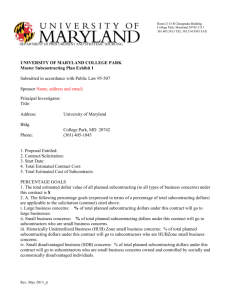Limitation-on-Subcontracting - National Defense Industrial Association
advertisement
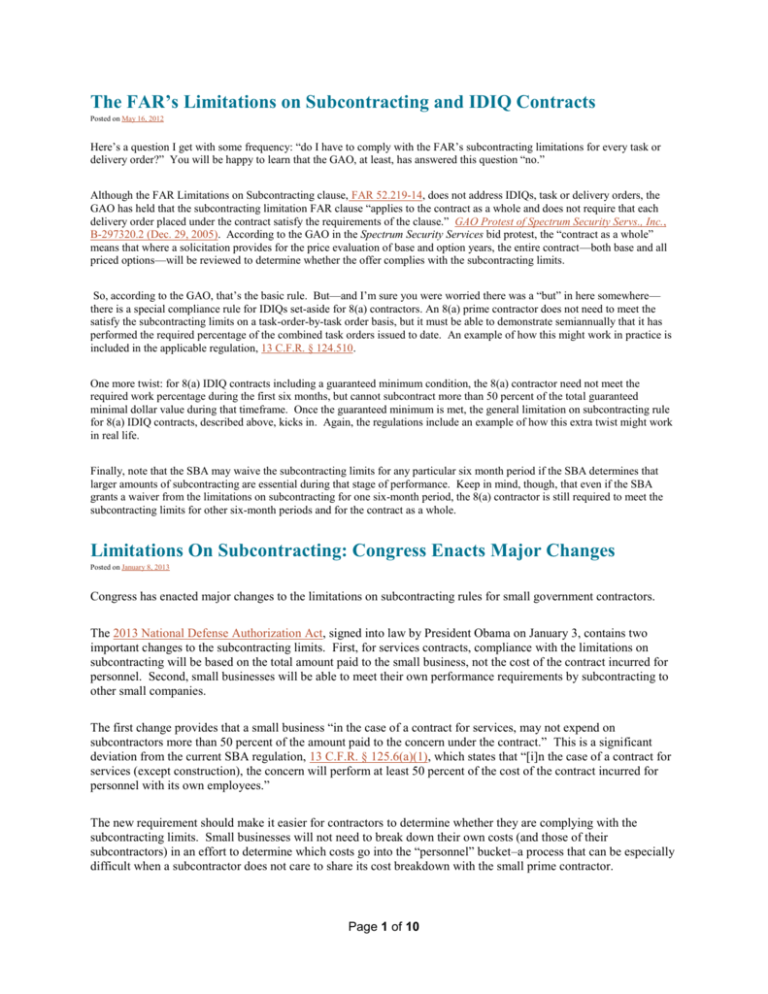
The FAR’s Limitations on Subcontracting and IDIQ Contracts Posted on May 16, 2012 Here’s a question I get with some frequency: “do I have to comply with the FAR’s subcontracting limitations for every task or delivery order?” You will be happy to learn that the GAO, at least, has answered this question “no.” Although the FAR Limitations on Subcontracting clause, FAR 52.219-14, does not address IDIQs, task or delivery orders, the GAO has held that the subcontracting limitation FAR clause “applies to the contract as a whole and does not require that each delivery order placed under the contract satisfy the requirements of the clause.” GAO Protest of Spectrum Security Servs., Inc., B-297320.2 (Dec. 29, 2005). According to the GAO in the Spectrum Security Services bid protest, the “contract as a whole” means that where a solicitation provides for the price evaluation of base and option years, the entire contract—both base and all priced options—will be reviewed to determine whether the offer complies with the subcontracting limits. So, according to the GAO, that’s the basic rule. But—and I’m sure you were worried there was a “but” in here somewhere— there is a special compliance rule for IDIQs set-aside for 8(a) contractors. An 8(a) prime contractor does not need to meet the satisfy the subcontracting limits on a task-order-by-task order basis, but it must be able to demonstrate semiannually that it has performed the required percentage of the combined task orders issued to date. An example of how this might work in practice is included in the applicable regulation, 13 C.F.R. § 124.510. One more twist: for 8(a) IDIQ contracts including a guaranteed minimum condition, the 8(a) contractor need not meet the required work percentage during the first six months, but cannot subcontract more than 50 percent of the total guaranteed minimal dollar value during that timeframe. Once the guaranteed minimum is met, the general limitation on subcontracting rule for 8(a) IDIQ contracts, described above, kicks in. Again, the regulations include an example of how this extra twist might work in real life. Finally, note that the SBA may waive the subcontracting limits for any particular six month period if the SBA determines that larger amounts of subcontracting are essential during that stage of performance. Keep in mind, though, that even if the SBA grants a waiver from the limitations on subcontracting for one six-month period, the 8(a) contractor is still required to meet the subcontracting limits for other six-month periods and for the contract as a whole. Limitations On Subcontracting: Congress Enacts Major Changes Posted on January 8, 2013 Congress has enacted major changes to the limitations on subcontracting rules for small government contractors. The 2013 National Defense Authorization Act, signed into law by President Obama on January 3, contains two important changes to the subcontracting limits. First, for services contracts, compliance with the limitations on subcontracting will be based on the total amount paid to the small business, not the cost of the contract incurred for personnel. Second, small businesses will be able to meet their own performance requirements by subcontracting to other small companies. The first change provides that a small business “in the case of a contract for services, may not expend on subcontractors more than 50 percent of the amount paid to the concern under the contract.” This is a significant deviation from the current SBA regulation, 13 C.F.R. § 125.6(a)(1), which states that “[i]n the case of a contract for services (except construction), the concern will perform at least 50 percent of the cost of the contract incurred for personnel with its own employees.” The new requirement should make it easier for contractors to determine whether they are complying with the subcontracting limits. Small businesses will not need to break down their own costs (and those of their subcontractors) in an effort to determine which costs go into the “personnel” bucket–a process that can be especially difficult when a subcontractor does not care to share its cost breakdown with the small prime contractor. Page 1 of 10 The change from “personnel cost” to “total contract price” also has the advantage of being intuitive. Over the years, I have spoken with many small contractors who mistakenly believed that the current regulation is based on the total contract price, and were very surprised to learn that they were supposed to be calculating their personnel costs. The 2013 NDAA aligns the limitations on subcontracting with the underlying expectations of many contractors. However, some small service contractors may be unhappy with the new rule. No longer can small contractors exclude the costs of materials, supplies and other non-labor costs from their subcontracting limit calculations. This means that many small companies may be forced to perform more work at the prime contract level in order to remain in compliance. Congress intended this result, desiring that at least 50% of the amount paid by the government on set-aside contracts go to small businesses. The 2013 NDAA also amends the subcontracting limits for supply contracts, providing that in the case of a contract for supplies, other than from a regular dealer in such supplies, the small business “may not expend on subcontractors more than 50 percent of the amount, less the cost of materials, paid to the concern under the contract.” Compare this requirement to the current regulation, 13 C.F.R. § 125.6(a)(2), which states that in the case of a supply contract, the small business “will perform at least 50 percent of the cost of manufacturing the supplies or products (not including the costs of materials.)” The 2013 NDAA does not address the limitations on subcontracting for general construction and specialty trade construction contracts, leaving such “other contracts” to the SBA’s discretion. For now, construction contractors can assume that the current subcontracting limits will remain in place. For small contractors worried that they will have to self-perform more work in order to meet the new subcontracting limitations, Congress has offered a lifeline of sorts. Under the new rules created by the 2013 NDAA, a small business may meet its own performance obligations by subcontracting to a “similarly situated entity.” In other words, a small business may satisfy its own performance requirements by subcontracting to another small business, an 8(a) company to another 8(a) company, and so on. The rule expands on similar authority currently available to SDVOSBs and HUBZone companies under 13 C.F.R. § 125.6. The “similarly situated entity” rule will allow small businesses greater flexibility to meet their performance of work obligations and should be welcomed by small government contractors. My only quibble with the provision is that Congress did not appear to clarify that “similarly situated entity” may vary based on the type of set-aside at issue. For instance, an 8(a) company may satisfy its performance requirements on an 8(a) set-aside by subcontracting to another 8(a) company, but that same 8(a) company should be able to satisfy its performance requirements on a small business set-aside by subcontracting to a non-8(a) small business. Hopefully, the SBA will make this clear when it adopts regulations based on the 2013 NDAA provision. Some small contractors may welcome the subcontracting limit changes enacted in the 2013 NDAA and others may disapprove. Regardless, Congress has spoken, and it is critical for all small government contractors to understand their new limitations on subcontracting obligations. SMALL BUSINESS—BE MINDFUL OF SUBCONTRACTING LIMITATIONS May 11, 2011, 10:48 am Filed under: Bid Protest, GAO, small business | Tags: 554 F.3d 1029, 8(a) firms, Addx Corporation, B-298364.7, B-404888, FAR, FAR 19.508(e), FAR 19.811-3e, FAR 52.219-14, Federal Acquisition Regulations, GAO, Government Accountability Office, Limitations on Subcontracting, small business, small business program, small business set-asides, subcontracting limitations The Government Accountability Office (GAO) recently reminded small businesses of the perils of submitting a proposal that does not provide a personnel/staffing plan that is consistent with the subcontracting limitations imposed in the Federal Acquisition Regulation (FAR) in connection with small business programs. Page 2 of 10 In Addx Corporation, B-404888, May 4, 2011, 2011 CPD para. ___, GAO upheld the agency’s rejection of a cost proposal for performance of a task order because the proposal took exception to the limitation on subcontracting clause. The proposal showed that approximately 78 percent of the small business’s personnel costs would be incurred for subcontractor personnel. This case illustrates an important lesson for small businesses and 8(a) firms-when submitting a proposal, a small business must ensure that its proposal does not take exception to the mandatory subcontracting limitations applicable to the type of work being procured. While the rules are simply stated in the FAR, small businesses continue to trip over the requirement generating litigation and loss of significant Government work. Background In the case of small business set-asides where the contract amount is expected to exceed $150,000 and 8(a) program solicitations and contracts, the FAR (sections 19.508(e) and 19.811-3e) requires the “Limitations on Subcontracting” clause in those solicitations and contracts. This FAR clause 52.219-14 (Limitations on Subcontracting), provides that by submission of an offer and execution of a contract, the Offeror/Contractor agrees that in performance of the contract in the case of a contract for – (1) Services (except construction). At least 50 percent of the cost of contract performance incurred for personnel shall be expended for employees of the concern. (2) Supplies (other than a procurement from a nonmanufacturer of supplies). The concern shall perform work for at least 50 percent of the cost of manufacturing the supplies, not including the cost of materials. (3) General Construction. The concern will perform at least 15 percent of the cost of the contract, not including the cost of materials, with its own employees. (For construction by special trade contractors, the concern must perform 25 percent of the cost of the contract excluding the cost of materials, with its own employees). Application of the Rule Where a proposal, on its face, should lead an agency to the conclusion that an offeror has not agreed to comply with the subcontracting limitation, the matter is one of the proposal’s acceptability. See The Centech Group Inc. v. United States and Tybrin Corp., 554 F. 3d 1029 (Fed. Cir. 2009) and Tybrin Corp., B-298364.6, B-298364.7, Mar. 13, 2007, 2007 CPD para. 51 at 5. The issue of compliance with the subcontracting limitation does not concern whether a bidder or offeror can or will comply with the subcontracting limitation requirement during performance of the contract, which is a matter is one of responsibility or in certain cases, contract administration, but rather, whether the bidder or offeror has specifically taken exception to the subcontracting limitation requirement on the face of its bid or proposal. Tybrin Corp, supra. Bottom Line A proposal that fails to conform to a material term or condition of the solicitation, including the subcontracting limitation, is unacceptable and may not form the basis for an award. Small business and 8(a) vendors need to ensure that their proposals and use of subcontractors are consistent with the limitations of the “Limitations on Subcontracting” clause. 13 CFR 125.6 - PRIME CONTRACTOR PERFORMANCE REQUIREMENTS (LIMITATIONS ON SUBCONTRACTING). § 125.6 Prime contractor performance requirements (limitations on subcontracting). Page 3 of 10 (a) In order to be awarded a full or partial small business set-aside contract, an 8(a) contract, a WOSB or EDWOSB contract pursuant to part 127 of this chapter, or an unrestricted procurement where a concern has claimed a 10 percent small disadvantaged business (SDB) price evaluation preference, a small business concern must agree that: (1) In the case of a contract for services (except construction), the concern will perform at least 50 percent of the cost of the contract incurred for personnel with its own employees. (2) In the case of a contract for supplies or products (other than procurement from a non-manufacturer in such supplies or products), the concern will perform at least 50 percent of the cost of manufacturing the supplies or products (not including the costs of materials). (3) In the case of a contract for general construction, the concern will perform at least 15 percent of the cost of the contract with its own employees (not including the costs of materials). (4) In the case of a contract for construction by special trade contractors, the concern will perform at least 25 percent of the cost of the contract with its own employees (not including the cost of materials). (b) An SDVO SBC prime contractor can subcontract part of an SDVO contract (as defined in § 125.15) provided: (1) In the case of a contract for services (except construction), the SDVO SBC spends at least 50% of the cost of the contract performance incurred for personnel on the concern's employees or on the employees of other SDVO SBCs; (2) In the case of a contract for general construction, the SDVO SBC spends at least 15% of the cost of contract performance incurred for personnel on the concern's employees or the employees of other SDVO SBCs; (3) In the case of a contract for construction by special trade contractors, the SDVO SBC spends at least 25% of the cost of contract performance incurred for personnel on the concern's employees or the employees of other SDVO SBCs; and (4) In the case of a contract for procurement of supplies or products (other than procurement from a nonmanufacturer in such supplies or products), at least 50% of the cost of manufacturing the supplies or products (not including the costs of materials), will be performed by the SDVO SBC prime contractor or other SDVO SBCs. (5) In accordance with § 125.15(b)(3), the SDVO SBC joint venture must perform the applicable percentage of work. (c) A qualified HUBZone SBC prime contractor can subcontract part of a HUBZone contract (as defined in § 126.600 of this chapter) provided: (1) In the case of a contract for services (except construction), the qualified HUBZone SBC spends at least 50% of the cost of the contract performance incurred for personnel on the concern's employees or on the employees of other qualified HUBZone SBCs; (2) In the case of a contract for general construction, the qualified HUBZone SBC spends at least 15% of the cost of contract performance incurred for personnel on the concern's employees; (3) In the case of a contract for construction by special trade contractors, the qualified HUBZone SBC spends at least 25% of the cost of contract performance incurred for personnel on the concern's employees; (4) In the case of a contract for procurement of supplies (other than procurement from a regular dealer in such supplies), the qualified HUBZone SBC spends at least 50% of the manufacturing cost (excluding the cost of materials) on performing the contract in a HUBZone. One or more qualified HUBZone SBCs may combine to meet this subcontracting percentage requirement; and (5) In the case of a contract for the procurement by the Secretary of Agriculture of agricultural commodities, the qualified HUBZone SBC may not purchase the commodity from a subcontractor if the subcontractor will supply the commodity in substantially the final form in which it is to be supplied to the Government. Page 4 of 10 (d) SBA may use different percentages if the Administrator determines that such action is necessary to reflect conventional industry practices among small business concerns that are below the numerical size standard for businesses in that industry group. Representatives of a national trade or industry group or any interested SBC may request a change in subcontracting percentage requirements for the categories defined by six digit industry codes in the North American Industry Classification System (NAICS) pursuant to the following procedures. (1) Format of request. Requests from representatives of a trade or industry group and interested SBCs should be in writing and sent or delivered to the Director, Office of Government Contracting, U.S. Small Business Administration, 409 3rd Street, SW., Washington, DC 20416. The requester must demonstrate to SBA that a change in percentage is necessary to reflect conventional industry practices among small business concerns that are below the numerical size standard for businesses in that industry category, and must support its request with information including, but not limited to: (i) Information relative to the economic conditions and structure of the entire national industry; (ii) Market data, technical changes in the industry and industry trends; (iii) Specific reasons and justifications for the change in the subcontracting percentage; (iv) The effect such a change would have on the Federal procurement process; and (v) Information demonstrating how the proposed change would promote the purposes of the small business, 8(a), SDB, woman-owned business, or HUBZone programs. (2) Notice to public. Upon an adequate preliminary showing to SBA, SBA will publish in the Federal Register a notice of its receipt of a request that it considers a change in the subcontracting percentage requirements for a particular industry. The notice will identify the group making the request, and give the public an opportunity to submit information and arguments in both support and opposition. (3) Comments. SBA will provide a period of not less than 30 days for public comment in response to the Federal Register notice. (4) Decision. SBA will render its decision after the close of the comment period. If SBA decides against a change, SBA will publish notice of its decision in the Federal Register. Concurrent with the notice, SBA will advise the requester of its decision in writing. If SBA decides in favor of a change, SBA will propose an appropriate change to this part. (e) Definitions. The following definitions apply to this section: (1) Cost of the contract. All allowable direct and indirect costs allocable to the contract, excluding profit or fees. (2) Cost of contract performance incurred for personnel. Direct labor costs and any overhead which has only direct labor as its base, plus the concern's General and Administrative rate multiplied by the labor cost. (3) Cost of manufacturing. Those costs incurred by the firm in the production of the end item being acquired. These are costs associated with the manufacturing process, including the direct costs of fabrication, assembly, or other production activities, and indirect costs which are allocable and allowable. The cost of materials, as well as the profit or fee from the contract, are excluded. (4) Cost of materials. Includes costs of the items purchased, handling and associated shipping costs for the purchased items (which includes raw materials), off-the-shelf items (and similar proportionately high-cost common supply items requiring additional manufacturing or incorporation to become end items), special tooling, special testing equipment, and construction equipment purchased for and required to perform on the contract. In the case of a supply contract, the acquisition of services or products from outside sources following normal commercial practices within the industry are also included. Page 5 of 10 (5) Off-the-shelf item. An item produced and placed in stock by a manufacturer, or stocked by a distributor, before orders or contracts are received for its sale. The item may be commercial or may be produced to military or Federal specifications or description. Off-the-shelf items are also known as Nondevelopmental Items (NDI). (6) Personnel. Individuals who are “employees” under § 121.106 of this chapter except for purposes of the HUBZone program, where the definition of “employee” is found in § 126.103 of this chapter. (7) Subcontracting. That portion of the contract performed by a firm, other than the concern awarded the contract, under a second contract, purchase order, or agreement for any parts, supplies, components, or subassemblies which are not available off-the-shelf, and which are manufactured in accordance with drawings, specifications, or designs furnished by the contractor, or by the government as a portion of the solicitation. Raw castings, forgings, and moldings are considered as materials, not as subcontracting costs. Where the prime contractor has been directed by the Government to use any specific source for parts, supplies, components subassemblies or services, the costs associated with those purchases will be considered as part of the cost of materials, not subcontracting costs. (f) Compliance will be considered an element of responsibility and not a component of size eligibility. (g) The period of time used to determine compliance will be the period of performance which the evaluating agency uses to evaluate the proposal or bid. If the evaluating agency fails to articulate in its solicitation the period of performance it will use to evaluate the proposal or bid, the base contract period, excluding options, will be used to determine compliance. In indefinite quantity contracts, performance over the guaranteed minimum will be used to determine compliance unless the evaluating agency articulates a different period of performance which it will use to evaluate the proposal or bid in its solicitation. (h) Work to be performed by subsidiaries or other affiliates of a concern is not counted as being performed by the concern for purposes of determining whether the concern will perform the required percentage of work. (i) Where an offeror is exempt from affiliation under § 121.103(h)(3) of this chapter and qualifies as a small business concern, the performance of work requirements set forth in this section apply to the cooperative effort of the joint venture, not its individual members. Question: Title - Small Business Set-Aside IDIQ and limits on subcontracting Question - In an IDIQ services contract where there was a small-business set-aside, does the Small Business have to perform over 50% of the work on each task order? Scenario - I thought I read that if a small business wins an IDIQ, Services Contract with a Small Business set-aside component, it did not have to perform more than 50% of the work on each individual task order (TO), but would have to perform more than 50% on average of those TOs awarded to them over the course of a year (or some other period of time). Is this correct? Posted - 1/12/2011 5:29:00 PM Subject Area - Contracting Page 6 of 10 Answer:Per 13 CFR Part 125: Prime contractor performance requirements (limitations on subcontracting). (a) In order to be awarded a full or partial small business set-aside contract, an 8(a) contract, a WOSB or EDWOSB contract pursuant to part 127 of this chapter, or an unrestricted procurement where a concern has claimed a 10 percent small disadvantaged business (SDB) price evaluation preference, a small business concern must agree that: (1) In the case of a contract for services (except construction), the concern will perform at least 50 percent of the cost of the contract incurred for personnel with its own employees. (2) In the case of a contract for supplies or products (other than procurement from a nonmanufacturer in such supplies or products), the concern will perform at least 50 percent of the cost of manufacturing the supplies or products (not including the costs of materials). (3) In the case of a contract for general construction, the concern will perform at least 15 percent of the cost of the contract with its own employees (not including the costs of materials). (4) In the case of a contract for construction by special trade contractors, the concern will perform at least 25 percent of the cost of the contract with its own employees (not including the cost of materials). This part of the CFR establishes the requirement for the small business to perform at least 50% of the work under the contract. The FAR does not further amplify this information relative to type of contract. You will need to review the terms and conditions of the specific contract to see if it spells out whether the 50% is by order or by overall contract. If it is not spelled out, recommend that you ask the Contracting Officer. Page 7 of 10 13 CFR 121.406 - HOW DOES A SMALL BUSINESS CONCERN QUALIFY TO PROVIDE MANUFACTURED PRODUCTS UNDER SMALL BUSINESS SET-ASIDE OR 8(A) CONTRACTS? § 121.406 How does a small business concern qualify to provide manufactured products or other supply items under a small business set-aside, service-disabled veteran-owned small business set-aside, WOSB or EDWOSB set-aside, or 8(a) contract? (a) General. In order to qualify as a small business concern for a small business set-aside, service-disabled veteranowned small business set-aside, WOSB or EDWOSB set-aside, or 8(a) contract to provide manufactured products or other supply items, an offeror must either: (1) Be the manufacturer or producer of the end item being procured (and the end item must be manufactured or produced in the United States); or (2) Comply with the requirements of paragraph (b), (c) or (d) of this section as a nonmanufacturer, a kit assembler or a supplier under Simplified Acquisition Procedures. (b) Nonmanufacturers. (1) A firm may qualify as a small business concern for a requirement to provide manufactured products or other supply items as a nonmanufacturer if it: (i) Does not exceed 500 employees; (ii) Is primarily engaged in the retail or wholesale trade and normally sells the type of item being supplied; (iii) Takes ownership or possession of the item(s) with its personnel, equipment or facilities in a manner consistent with industry practice; and (iv) Will supply the end item of a small business manufacturer, processor or producer made in the United States, or obtains a waiver of such requirement pursuant to paragraph (b)(5) of this section. (2) For size purposes, there can be only one manufacturer of the end item being acquired. The manufacturer is the concern which, with its own facilities, performs the primary activities in transforming inorganic or organic substances, including the assembly of parts and components, into the end item being acquired. The end item must possess characteristics which, as a result of mechanical, chemical or human action, it did not possess before the original substances, parts or components were assembled or transformed. The end item may be finished and ready for utilization or consumption, or it may be semifinished as a raw material to be used in further manufacturing. Firms which perform only minimal operations upon the item being procured do not qualify as manufacturers of the end item. Firms that add substances, parts, or components to an existing end item to modify its performance will not be considered the end item manufacturer where those identical modifications can be performed by and are available from the manufacturer of the existing end item: (i) SBA will evaluate the following factors in determining whether a concern is the manufacturer of the end item: (A) The proportion of total value in the end item added by the efforts of the concern, excluding costs of overhead, testing, quality control, and profit; (B) The importance of the elements added by the concern to the function of the end item, regardless of their relative value; and (C) The concern's technical capabilities; plant, facilities and equipment; production or assembly line processes; packaging and boxing operations; labeling of products; and product warranties. Page 8 of 10 (ii) Firms that provide computer and other information technology equipment primarily consisting of component parts (such as motherboards, video cards, network cards, memory, power supplies, storage devices, and similar items) who install components totaling less than 50% of the value of the end item are generally not considered the manufacturer of the end item. (3) The nonmanufacturer rule applies only to procurements that have been assigned a manufacturing or supply NAICS code. The nonmanufacturer rule does not apply to contracts that have been assigned a service, construction, or specialty trade construction NAICS code. (4) The nonmanufacturer rule applies only to the supply component of a requirement classified as a manufacturing or supply contract. If a requirement is classified as a service contract, but also has a supply component, the nonmanufacturer rule does not apply to the supply component of the requirement. Example 1 to paragraph (b)(4). A procuring agency seeks to acquire computer integration and maintenance services. Included within that requirement, the agency also seeks to acquire some computer hardware. If the procuring agency determines that the principal nature of the procurement is services and classifies the procurement as a services procurement, the nonmanufacturer rule does not apply to the computer hardware portion of the requirement. This means that while a contractor must meet the applicable performance of work requirement set forth in § 125.6 for the services portion of the contract, the contractor does not have to supply the computer hardware of a small business manufacturer. Example 2 to paragraph (b)(4). A procuring agency seeks to acquire computer hardware, as well as computer integration and maintenance services. If the procuring agency determines that the principal nature of the procurement is for supplies and classifies the procurement as a supply procurement, the nonmanufacturer rule applies to the computer hardware portion of the requirement. A firm seeking to qualify as a small business nonmanufacturer must supply the computer hardware manufactured by a small business. Because the requirement is classified as a supply contract, the contractor does not have to meet the performance of work requirement set forth in § 125.6 for the services portion of the contract. (5) The Administrator or designee may waive the requirement set forth in paragraph (b)(1)(iii) of this section under the following two circumstances: (i) The contracting officer has determined that no small business manufacturer or processor reasonably can be expected to offer a product meeting the specifications (including period for performance) required by a particular solicitation and SBA reviews and accepts that determination; or (ii) SBA determines that no small business manufacturer or processor of the product or class of products is available to participate in the Federal procurement market. (6) The two waiver possibilities identified in paragraph (b)(5) of this section are called “individual” and “class” waivers respectively, and the procedures for requesting and granting them are contained in § 121.1204. (7) Any SBA waiver of the nonmanufacturer rule has no effect on requirements external to the Small Business Act which involve domestic sources of supply, such as the Buy American Act. (c) Kit assemblers. (1) Where the manufactured item being acquired is a kit of supplies or other goods provided by an offeror for a special purpose, the offeror cannot exceed 500 employees, and 50 percent of the total value of the components of the kit must be manufactured by business concerns in the United States which are small under the size standards for the NAICS codes of the components being assembled. The offeror need not itself be the manufacturer of any of the items assembled. (2) Where the Government has specified an item for the kit which is not produced by U.S. small business concerns, such item shall be excluded from the calculation of total value in paragraph (c)(1) of this section. Page 9 of 10 (d) Simplified Acquisition Procedures. Where the procurement of a manufactured item is processed under Simplified Acquisition Procedures, as defined in § 13.101 of the Federal Acquisition Regulation (FAR) ( 48 CFR 13.101 ), and where the anticipated cost of the procurement will not exceed $25,000, the offeror need not supply the end product of a small business concern as long as the product acquired is manufactured or produced in the United States, and the offeror does not exceed 500 employees. The offeror need not itself be the manufacturer of any of the items acquired. (e) These requirements do not apply to small business concern subcontractors. Page 10 of 10


